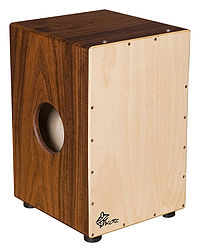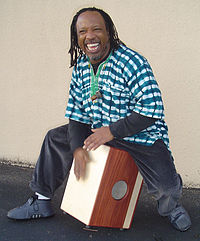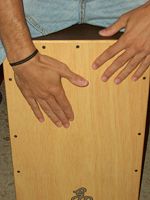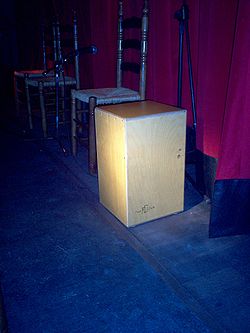- Cajón
-
This article is about the musical instrument. For the city, see El Cajon, California.
A cajón (Spanish pronunciation: [kaˈxon], "crate," "drawer," or "box") is a box-shaped percussion instrument originally from Peru, played by slapping the front face (generally thin plywood) with the hands.
Contents
Origins and evolution
The cajón is the most widely used Afro-Peruvian musical instrument since the late 18th century.[1]
Slaves of west and central African origin in the Americas, specifically Peru, are considered to be the source of the cajón drum; though the instrument is common in musical performance throughout the Americas.
The cajón was most likely developed in coastal Peru during the early 19th century or before,[1] where it is associated with several Afro-Peruvian genres. The instrument reached a peak in popularity by 1850, and by the end of the 19th century cajón players were experimenting with the design of the instrument by bending some of the planks in the cajón's body to alter the instrument's patterns of sound vibration.[1]
Knowing that the cajón comes from slave musicians in the Spanish colonial Americas, there are two complementary origin theories for the instrument. It is possible that the drum is a direct descendant of a number of boxlike musical instruments from west and central Africa, especially Angola, and the Antilles. These instruments were adapted by Peruvian slaves from the Spanish shipping crates at their disposal.[2] In port cities like Matanzas, Cuba they used cod-fish shipping crates. Elsewhere, small dresser drawers became instruments.
Another theory posits that slaves simply used boxes as musical instruments to combat contemporary Spanish colonial bans on music in predominantly African areas.[3] In this way, cajóns could easily be disguised as seats or stools, thus avoiding identification as musical instruments. In all likelihood it is a combination of these factors - African origins and Spanish suppression of slave music - that led to the cajón's creation.
Early usage of the Peruvian cajón was to accompany Tondero and Zamacueca (old version of Marinera) dances.
In contemporary times, the instrument became an integral part of Peruvian music and Cuban music. In Cuba, it is known as a Cuban box drum that was originally used to play Rumba Yambu and now incorporated into many other styles. The bass box drum is large enough to sit on and is played with the palm, fist and fingers. It was originally a crate from shipping cod fish in Havana. The middle drum is played with spoons and was originally a box from church candles. The solo drum started as a desk drawer but has evolved into a specialized box made for this purpose. A more recent contribution to the cajón family is a tall, tapered box resembling a square ashiko. Another is the "Batajon " an innovative cajón invented by Fat Congas of Santa Barbara, with two heads like a Batá drum.
In the 1970s, Peruvian composer and cajón master Caitro Soto gave a cajón as a present to Spanish guitarist Paco de Lucía during one of his visits to Peru. De Lucía liked the sounds of this instrument so much that before leaving the country he bought a second cajón. Later he introduced the cajón to flamenco music.
The drum
Half to three quarter inch (1.3 to 2 cm) thick wood is generally used for five sides of the box. A thin sheet of plywood is nailed on as the sixth side and acts as the striking surface or head. A sound hole is cut on the back side opposite the head or tapa.
The top edges are often left unattached and can be slapped against the box. The player sits astride the box, tilting it at an angle while striking the head between his knees. The modern cajón has several screws at the top for adjusting percussive timbre and may sport rubber feet. Some versions may also have several vertically stretched cords pressed against the tapa for a buzz like effect or tone. Guitar strings, rattles or drum snares may serve this purpose. The percussionist can play the sides with the top of his palms and fingers for additional sounds. There are also tube cajón, which are played like a conga.
Today
Today, the cajón is heard extensively in Cuban, Coastal Peruvian or Musica criolla musical styles: Tondero, Zamacueca and Peruvian Waltz, modern Flamenco and certain styles of modern Rumba. The cajón was introduced into flamenco in the 1970s by guitarist Paco de Lucía. While in Peru, he was given the cajón by percussionist Caitro Soto. In the Paco de Lucia sextet, the cajón is played by Brazilian percussionist Rubem Dantas.
The modern cajón is often used to accompany the acoustic guitar and is showing up on worldwide stages in contemporary music. American acoustic rock band, Boyce Avenue, uses the Cajón in some of their new covers, such as: "Here Without You" (3 Doors Down) and "Just Can't Get Enough" (Black Eye Peas).
Different uses of the Cajón
Besides its standard use, the cajon has been played in a variety of ways, according to the influences it has been under over time. Since it has been widely spread across the world, not only percussionists, but also other musicians have begun to play the cajon. The instrument has been played not only with hands, but also with plastic and metal brushes, as normally used for drums. Another way of playing the cajon is to use an ordinary bass drum pedal, thus turning the cajon into an indirect percussion instrument. This enables the player to beat it just like a pedal-bass-drum, but it also restricts the player's standard position.
In February 2008, the Italian percussionist Ovidio Venturoso invented and patented an apparatus for playing the cajon both with hands and a pedal, without changing the standard position.
 Setup example percussion, drums with Cajón replacing the Bassdrum
Setup example percussion, drums with Cajón replacing the BassdrumConsequently, a player can use both hands and feet and gain greater scope for artistic expression.
Furthermore, the pedal apparatus enables the Cajón to be played in a creative drum-set.
The Puerto Rican musician Pedro Barriera has designed "wooden bongos".
In the Philippines, it has ushered a new breed of percussionists in the "acoustic" club circuit.
In 2001 the Cajón was declared "National Patrimony" by the Peruvian National Institute of Culture.
Notable Cajón users
See also
- Cajón (Mexico)
- Cañete
- Afro-Peruvian music
- Flamenco
- Peru
- Music of Cuba
Notes
- ^ a b c Tompkins, William David: "Afro-Peruvian Traditions" in "Music of the African Diaspora in the Americas," p. 493. Springer US Press, 2005
- ^ Feldman, Heidi: "Black Rhythms of Peru" p. 21-22. Wesleyan University Press, 2006
- ^ Feldman, Heidi: "Black Rhythms of Peru" p. 22. Wesleyan University Press, 2006
External links
- Kopf Percussion | Percussion Instrument Manufacturer
- Top Quality Cajon Manufacturer - Pratley Percussion
- How to Build a Cajón
- Videos of a cajon being played
- Afro-Cuban cajón in religious ceremonies
- Instruments of the World - Cajon
- Cajón peruano solo
- Brief history of the instrument with photo.
Percussion instruments Tuned agogô · balafon · bell · bells · bonang · caisa · carillon · celesta · crotales · flexatone · glockenspiel · gong · handbell · handchime · hang · jal tarang · kulintang · kulintang a kayo · marimba · octoban · skrabalai · steelpan · spinet · tank drum · timpani · tubular bells · vibraphone · xylophoneNon-tuned agogô · bass drum · batá drum · bell tree · bock-a-da-bock · bodhrán · bongo drum · cabasa · cajón · castanets · chácaras · china cymbal · clapsticks · claves · cowbell · conga drum · crash cymbal · cymbal · djembe · darabouka · dayereh · floor tom · gong · güiro · headless tambourine · hi-hat · jam block · lagerphone · maracas · Manjira · mark tree · pandeiro · ratchet · ride cymbal · rototom · rute · sizzle cymbal · snare drum · splash cymbal · spoons · swish cymbal · tabor · taal · tambourine · temple blocks · thunder sheet · timbales · tom-tom · triangle · vibraslap · washboard · whip · wind chime · wood blockRelated Percussion Portal Categories:- Percussion instruments
- Peruvian musical instruments
- Cuban musical instruments
Wikimedia Foundation. 2010.




